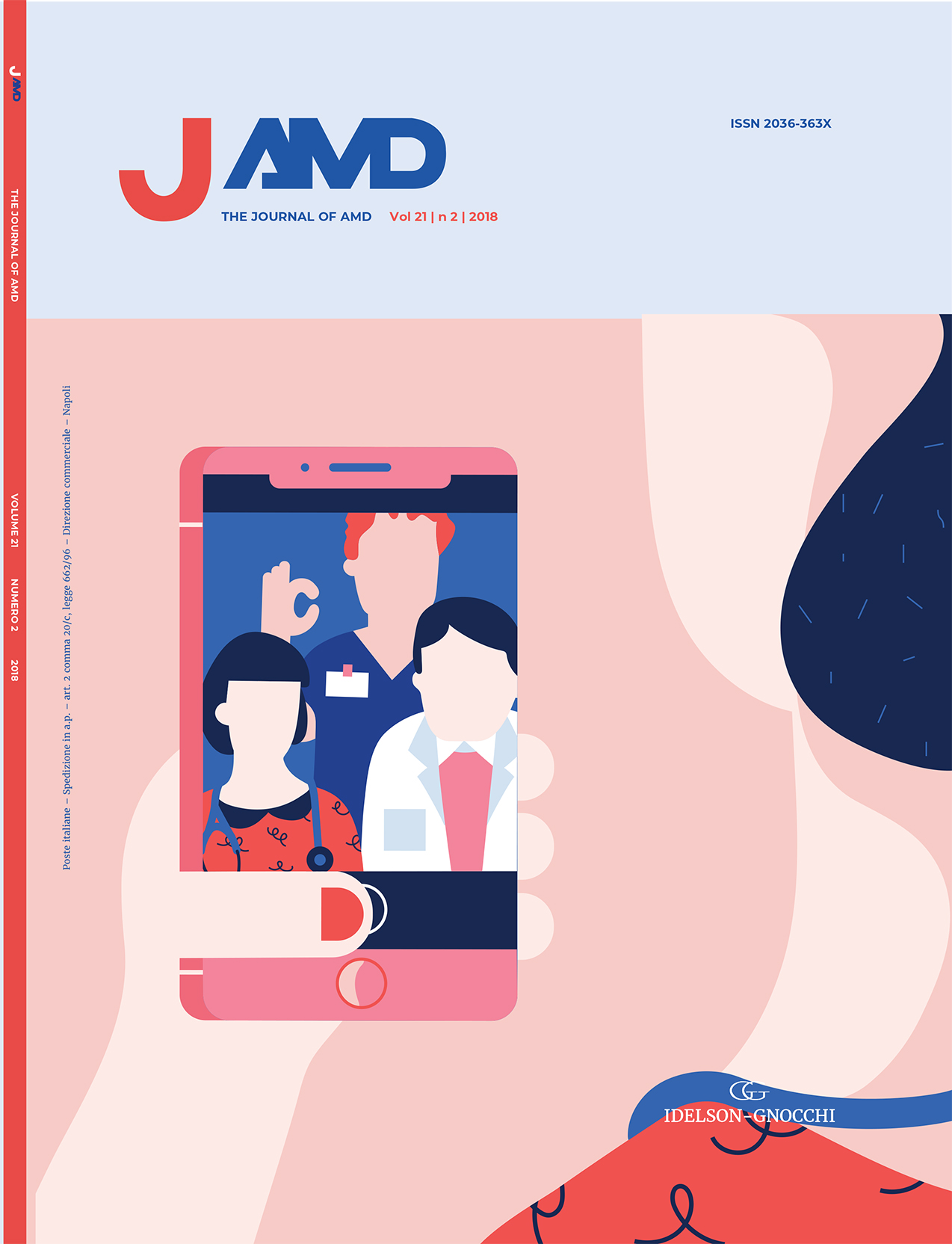ISS (Istituto Superiore di Sanità) and AMD (Associazione Medici Diabetologi) – an alliance for the enhancement of telemedicine in diabetology
JAMD 2018;21(2):82-85
Original articles
Analysis of characteristics of patients af¬fected by pathology of the diabetic foot of ASP Palermo territorial polyambulator
JAMD 2018;21(2):86-93
“Diabetic foot” plays a major role in diabetology from both the clinical and social perspectives. Consequence of its macro/micro vascular and neuropathic complications is among the leading causes of hospitalization and not traumatic lower limb amputations. Patients with foot ulcers suffer also a reduction of their quality of life.
AIM To describe diabetic patients’ characteristics suffering from foot ulcers who access territorial care.
MATERIALS AND METHODS We conducted an descriptive retrospective observational study of patients with ulcerat the foot. Personal and socio-sanitary data were recorded Also duration of the disease, practiced therapy and foot conditions: skin, monofilament pressure sensitivity, transcutaneousoxygen pressure, vibrator sensitivity to biotesiometer and Ankle Brachial Pressure Index (ABPI) evaluation. As a marker of glycemic remedy we analyzed the value of HbA1C. They were analyzed as cardiovascular risk factors hypertension and Body Mass Index (BMI). Foot injuries have been classified with the University of Texas Wound Classification System. The correlations between patient foot injuries and variables have been analyzed, such as comorbidity with the Cumulative Illness Rating Scale (CIRS), BMI.
RESULTS Our study shown a greater incidence of foot injuries in diabetic patients with simultaneous serious illnesses compared to the severity of a single pathology. The gender is not relevant characteristic to the HbA1c values.
CONCLUSIONS The comorbidity showed to be a significant risk factor compared to other characteristic examined. We consider it useful to launch health promotion programs by organizing self-help groups, involving care givers in the management of the disease.
Mindfulness: a new tool for the person with diabetes and for the chronic health worker. Literature Review
JAMD 2018;21(2):93-98
The management of diabetes as a chronic disease requires constant care, adjustments of therapy and strong engagement of both the person with diabetes and the whole care team. However despite the educational and pedagogical efforts, the patient’s adherence to the continuity of care, learning and conscious self-management of the illness, may remain open critical issues. The psycho-emotional component and its management can be an obstacle for good compensation and management of the disease. In this context training and engagement of health professionals is included in the management. Psycho-emotional difficulties such as depression, anxiety, alexithymia, emotional detachment and burnout may occur both patient and health professional and affect the relationship between figures involved in the treatment and consequently disease menagement. Mindfulness is an educational program based on awareness for the management of stress linked to chronic diseases and it was born in the ’80s in the United States. During this program, strategies for the recognition and management of thoughts and emotions are explored through lay meditation practices and awareness strategies. This review of the literature shows the use and effectiveness of mindfulness both for the person with diabetes and for the health worker with positive implications for the psycho-emotional component, stress and management of the chronic pathology and the help relationship.
KEYWORDS diabetes management; mindfulness; burnout; psychopathology; emotional engagement.
SELFIE project: identification of barriers to treatment intensification in type 2 diabetes
JAMD 2018;21(2):99-106
Several therapeutic options are currently available for the treatment of type 2 diabetes, but many patients are still treated with traditional classes of drugs (metformin, secretagogues and insulin). The new classes of glucose lowering drugs, particularly DPP-4 inhibitors, can have a better efficacy and safety profile than the traditional ones, allowing the achievement of the therapeutic target with a lower risk of hypoglycaemia. However, the new available drugs are still underutilized, with marked territorial disparities in their prescription. Furthermore, the problem of therapeutic inertia, i.e. an excessive delay in the intensification of the treatment in the presence of inadequate metabolic control, is largely recognized. The SELFIE project (SELF assessment for therapeutic approprIatEness in the diabetic patient) was designed to investigate the perceptions and opinions of 60 diabetologists in 12 meetings. The aim was to stimulate the debate between experts through a structured discussion, to identify the main “barriers to intensification”. The discussion was focused on the identification of specific barriers relative to 8 different profiles (phenotypes) of patients with poor metabolic control and categorized by age, renal function and treatment with mono or polytherapy. The final output of the project is a document summarizing the barriers to be tackled in different types of patients. From the criticalities emerged, proactive actions for therapy intensification and future educational interventions aimed at reducing therapeutic inertia will be implemented; enabling patients to receive timely, effective and safe care is the key step for the prevention of diabetes complications.
KEY WORDS therapeutic inertia; barriers; DPP-4 inhibitors; education.
Distal technologies impact, Telehealth and mHealth, on type 1 diabetes self-management: a narrative review
JAMD 2018;21(2):107-118
AIM To evaluate the possible influences of new technologies on quality of life, disease and complications management (self-management) in children, teenagers and young adults with type 1 diabetes mellitus (T1DM).
RESEARCH DESIGN Narrative review.
MATERIALS AND METHODS We performed a research through scientific/medical database: PubMed, Cinahl, The Cochrane Library, Proquest Central, Phych INFO and UpToDate, applying the following filters: studies in humans, English language and most recent publication (from 2007 to 2017).Only those responding to the following selection criteria have been selected:
- Quantitative studies.
- Use of quantitative evaluation tools, monitoring quality of life and self-management.
- Reference population of age group less than 65 years old.
- Focus on usefulness, satisfaction and technologies influence on quality of life and disease self-management of T1DM subjects (outcomes).
RESULTS Among the selected articles, only 7 were fitting the inclusion criteria of this review. Overall, despite some studies did not show significant differences in quality of life, results showed an increased frequency in Self Monitoring Bloog Glucse (SMBG) and an improved metabolic control with the use of new technologies, especially in young teenagers with T1DM.
CONCLUSION The different studies showed the potential advantages and the overall feasibility of using new apps on mobile technologies, that appear to be mostlyeffective in young teenagers affected by chronic disease, such as T1DM. These data suggest to identify new effective and acceptable technologies that may be useful to enhance care adherence and impact on quality of life in young T1DM patients.
KEY WORDS type 1 diabetes mellitus; self-management; SMBG (self-monitoring of blood glucose); mobile technologies; telemedicine; quality of life.
Insulin pump therapy in type 2 diabetes: a consensus proposal
JAMD 2018;21(2):119-131
Why a consensus? The availability of recommendations regarding the choice and use of pump therapy (CSII) in the diabetic type 2 patient (DMT2) in intensive insulin treatment (MDI) is limited, but the need for greater cleareness and sharing of aims is perceived from professionals as a necessity. Despite the clinical evidence, its use in Italy is still limited to sporadic cases and that is why a group of diabetologists experts in technology has decided to confront and propose this consensus
KEYWORDS type 2 diabetes; insulin pump therapy.
Punto di vista
Diabetic foot from “Cinderella syndrome” to a super speciality of diabetes
JAMD 2018;21(2):132-134
Consensus document
Clinical pathway for inpatients oncologic patients with diabetes
JAMD 2018;21(2):135-148
Diabetes and cancer frequently coexist in the same subject, often with relevant clinical effects on the management and prognosis of the oncologic patient. However, existing guidelines do not deal with many clinical issues in this setting appropriately. Albeit collaboration between Diabetologists and Oncologists should play an important role in achieving appropriate levels of care, a high level of coordination or agreement between these specialists is seldom offered. There is an urgent need of a greater interdisciplinary integration between all specialists involved in this setting, to reach a shared approach ensuring that a compartmentalized organization is overcome. To this end the Italian Associations of Medical Diabetologists (AMD) and of Clinical Oncologists (AIOM) have created the Working Group “Diabetes and cancer”. The working group, together with other experts from the Group “Diabetes Inpatient” by AMD, has prepared a diagnostic and therapeutic clinical pathway for the hospitalized oncological patient with diabetes. Herein we describe some suggested measures to assess, monitor and improve glycemic control within the hospital environment, integrating different specialists from both areas, as well as discharge planning specific for diabetes.
KEYWORDS clinical pathways; diabetes and cancer; inpatient diabetes care; inpatient hyperglycemia; oncology.
Il diabetologo e la pratica clinica
Therapeutic education for adult patients: managing hypoglycemia through type 1 insulin pump therapy
JAMD 2018;21(2):149-156
Hypoglycemia is the main limiting factor in type 1 and 2 diabetes therapy. It is still frequent within patients using insulin pumps: in fact, it increases as the patient is treated more intensively, with glycemic objectives close to the average level. This raises the need to teach the patient and his family to recognize hypoglycemia and to correct it promptly. The aim of courses directed to patients following an insulin pump therapy is to provide a deeper and more structured knowledge about the disease and the use of the instrument and allow patients to identify patterns of risky situations in order to prevent them and react with proper strategies and behaviors to improve their health status and their capability to handle the illness. Regarding hypoglycemia Pordenone’s diabetes care unit has elaborated an educational intervention in the form of a game addressed to reduce risk and frequency of hypoglycemia cases. The intervention-game simulates three different patterns of the dysfunction through different examples of glycemic diary.
KEYWORDS type 1 diabetes mellitus; hypoglycemia; therapeutic education; structured education program; subcutaneous insulin infusion (CSII).
Le News di AMD
Progetto RADAR
Attivazione di un sistema di identificazione proattiva dei pazienti con DM2 con inadeguato controllo metabolico al fine del miglioramento dell’appropriatezza prescrittiva




